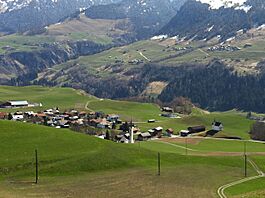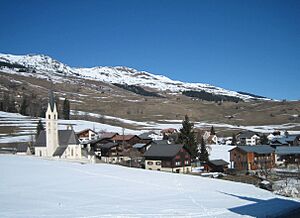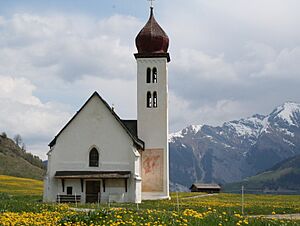Degen, Switzerland facts for kids
Quick facts for kids
Degen
|
||
|---|---|---|
 |
||
|
||
| Country | Switzerland | |
| Canton | Graubünden | |
| District | Surselva | |
| Area | ||
| • Total | 6.72 km2 (2.59 sq mi) | |
| Elevation | 1,122 m (3,681 ft) | |
| Population
(Dec 2011)
|
||
| • Total | 235 | |
| • Density | 34.97/km2 (90.57/sq mi) | |
| Postal code |
7145
|
|
| Surrounded by | Vella, Vignogn, Suraua, Obersaxen. | |
Degen is a small, former town (called a municipality) in the Graubünden area (canton) of Switzerland. It's located in the Surselva district. Before 1983, it was known as Igels. On January 1, 2013, Degen joined with several other nearby towns like Cumbel and Vella to form a new, larger municipality called Lumnezia.
Contents
A Look Back: Degen's History
Degen has a long history! It was first written about around the year 840. Back then, it was called Higenae or Egenae. Another nearby place, Rumein, was also mentioned around the same time. Later, in 1325, the hamlet of Vattiz was first recorded.
Exploring Degen's Geography
Degen covers an area of about 6.8 square kilometers (2.6 square miles). A large part of this land, about 78%, is used for farming. Forests cover about 11% of the area. Around 4% of the land has buildings or roads, and the rest (7%) is made up of rivers, mountains, or glaciers.
The former town sits on a flat area (a terrace) about 200 meters (656 feet) above the Glenner valley. It includes the main village of Degen and two smaller communities called Rumein and Vattiz.
Understanding Degen's Coat of Arms
The coat of arms for Degen is a special design. It has a black background with a gold star on one side. On the other side, it has a gold background with a black zig-zag line. This design helps represent the town's unique identity.
People and Life in Degen
In 2011, Degen had a population of 235 people. A small part of the population, about 5.3%, were people from other countries in 2008. Over the past ten years, the number of people living in Degen has gone down by about 14.6%.
Most people in Degen speak Romansh, which is a language spoken in parts of Switzerland. About 73.7% of the people spoke Romansh in 2000. German was the second most common language (20.6%), and Albanian was third (3.6%).
In 2000, slightly more than half of the population (53.8%) were male, and 46.2% were female. The population included many young people: about 12.1% were children under 10, and 13.8% were teenagers between 10 and 19.
Most people in Degen are well-educated. About 59.7% of adults (aged 25-64) have finished high school or gone on to higher education, like university.
Degen has a very low unemployment rate of 0.4%. This means almost everyone who wants a job has one. In 2005, many people worked in farming (42 people in 23 businesses). Some worked in manufacturing (17 people in 3 businesses), and others worked in services like shops or tourism (18 people in 10 businesses).
How Degen's Population Changed
| Population change in Degen | |||||||||||||||||||
|---|---|---|---|---|---|---|---|---|---|---|---|---|---|---|---|---|---|---|---|
| Year | 1808 | 1850 | 1900 | 1950 | 2000 | ||||||||||||||
| Population | 232 | 255 | 214 | 323 | 247 | ||||||||||||||
Important Heritage Sites
The Chapel of St. Sebastian in Degen is a very important building. It is listed as a Swiss heritage site of national significance. This means it's a special place that is protected because of its history and cultural value.
See also
 In Spanish: Degen (Grisones) para niños
In Spanish: Degen (Grisones) para niños







